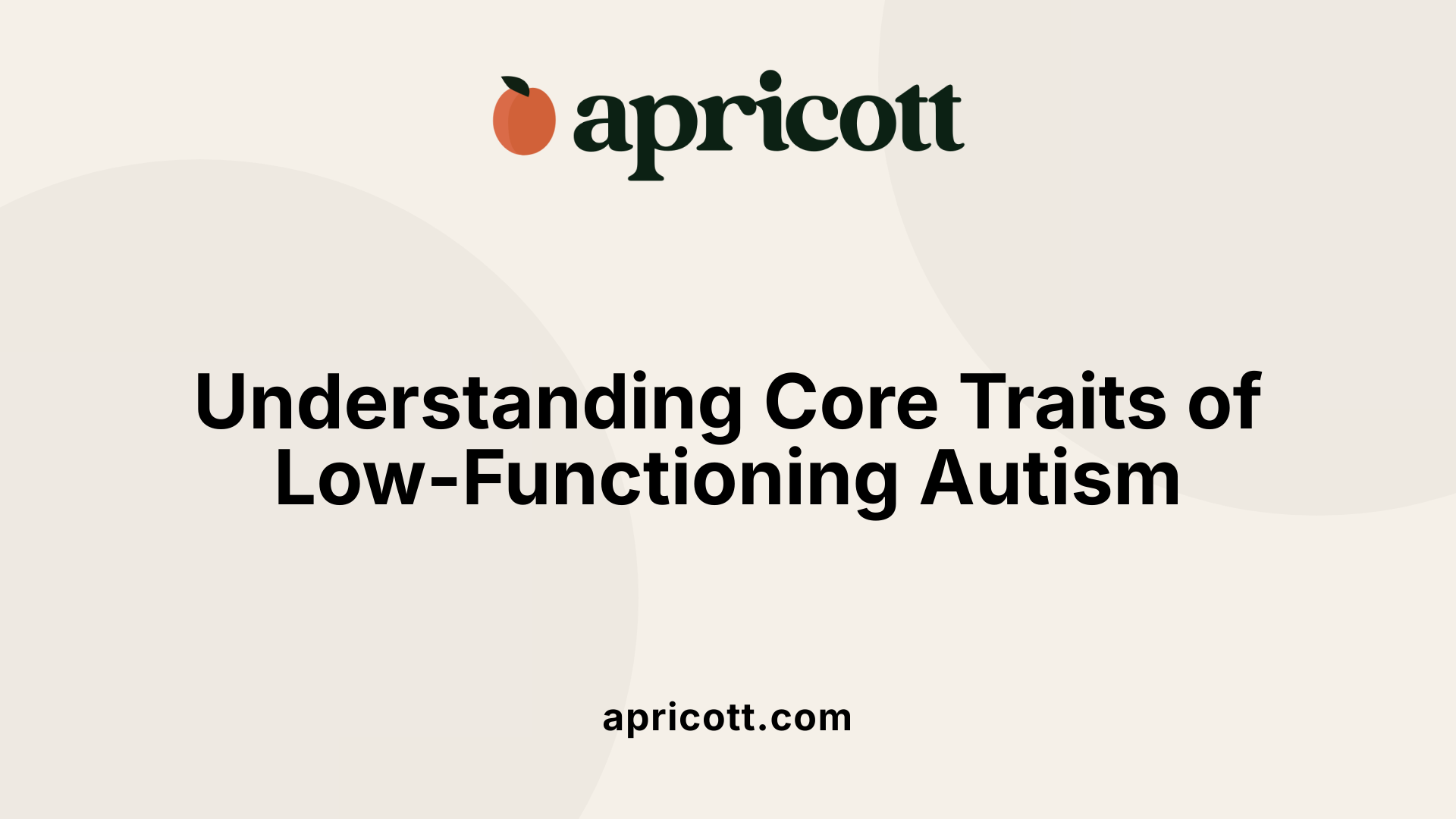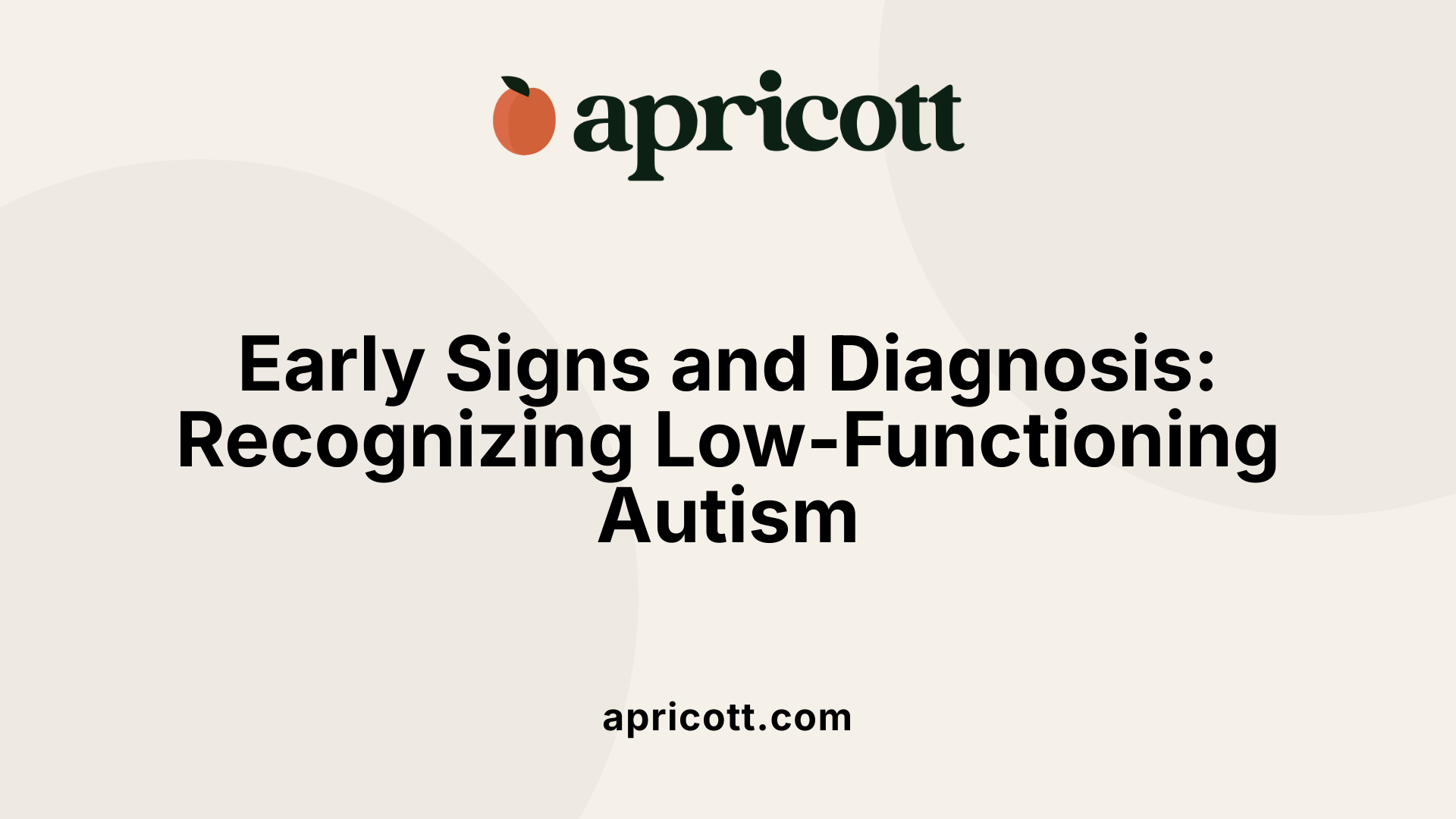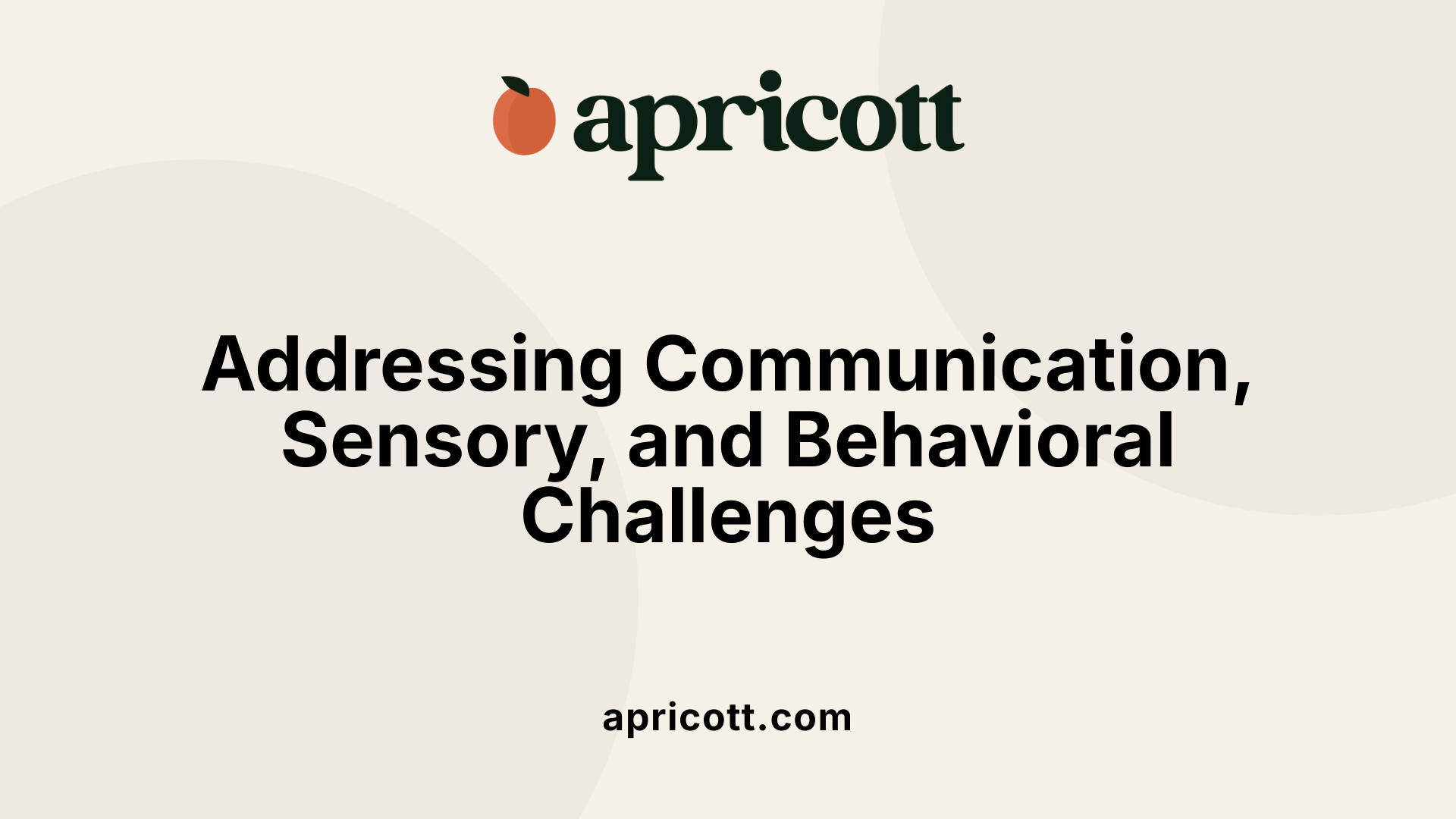Introduction to Low-Functioning Autism
Low-functioning autism (LFA) is the most severe presentation within the autism spectrum disorder (ASD), characterized by profound impairments in communication, social interaction, and daily functioning. It predominantly affects individuals diagnosed as Level 3 ASD, requiring lifelong, substantial support. Recognizing the complexities of low-functioning autism is crucial for fostering awareness, improving support systems, and tailoring interventions to enhance quality of life for affected individuals.
Defining Low-Functioning Autism and Its Core Traits

What is low-functioning autism?
Low-functioning autism (LFA) describes individuals diagnosed with the most severe form of autism spectrum disorder (ASD), known officially as Level 3 ASD. These individuals face profound challenges in communication, social interaction, and independent living. They often cannot verbalize their needs and may be entirely nonverbal. Their daily life involves substantial support for basic activities such as grooming, dressing, and safety supervision.
What are the characteristics such as communication difficulties and severe impairments?
Children and adults with low-functioning autism exhibit notable deficits in verbal and nonverbal communication. Many are nonverbal or speak with an abnormal tone, rhythm, or without understanding the conversational context. They might echolalia, repeating phrases verbatim, or display limited expressive language.
In terms of social interaction, these individuals usually have minimal awareness of social cues, lack empathy, and demonstrate limited social engagement. They may display stereotypic or repetitive behaviors like hand flapping, rocking, or spinning, which serve as forms of self-stimulation or coping mechanisms.
Children with LFA often show delayed motor development, such as sitting up, crawling, or walking later than typical developmental milestones. They may also have difficulty with fine motor skills needed for tasks like grooming and dressing.
Presence of intellectual disability and sensory disturbances
Most individuals with low-functioning autism have intellectual disabilities, with IQ scores often below 80, although some may possess savant skills or exceptional talents.
Sensory processing issues are common, resulting in over-reactivity or under-reactivity to stimuli like sounds, lights, textures, and smells. These sensory disturbances can lead to heightened anxiety, behavioral outbursts, or withdrawal.
Early signs and diagnosis
Early signs include delays in motor skills, speech difficulties, limited eye contact, and resistance to routine changes. Recognizing these signs as early as infancy facilitates prompt diagnosis.
The diagnosis process typically involves a multidisciplinary team assessment that may include behavior questionnaires, communication and behavioral observations, and evaluations of daily functioning. This comprehensive approach helps determine the level of support required.
Support strategies and implications
Children with low-functioning autism usually need ongoing, intensive therapies to improve communication and reduce maladaptive behaviors. Applied Behavioral Analysis (ABA), speech therapy, occupational therapy, and sensory integration therapy are common interventions.
Safety concerns are significant; individuals may not recognize danger, leading to risks such as wandering, head-banging, or self-injury. Caregivers and educators must implement safety proofing measures and supervision tools.
Educational programming should be personalized, focusing on life skills and community participation rather than solely academic achievement. Using visual cues, real-world practice, and continuous support can improve learning outcomes.
Despite these challenges, many adults who had severe childhood disabilities are now able to live independently or with appropriate support. Recognizing individual strengths and tailoring interventions accordingly can support meaningful progress and better quality of life.
Recognizing Symptoms and Diagnostic Process

What are the symptoms and diagnostic criteria for low-functioning autism?
Low-functioning autism, classified as Level 3 ASD, manifests with profound difficulties in communication and social interaction. Individuals often exhibit limited or absent verbal language, making communication a significant challenge. They show poor eye contact, are less responsive to social cues, and may struggle to form relationships.
Repetitive and stereotypic behaviors are common; these include hand-flapping, rocking, spinning, or self-injurious actions such as head-banging or biting. Sensory sensitivities, such as overreacting to sounds, textures, or lights, can worsen these behaviors.
Intellectual disability is a hallmark, with IQ scores typically below 80, although some individuals may possess exceptional savant skills. Delays in motor development—like sitting up, crawling, and walking—are often observed along with difficulty performing daily activities such as grooming and dressing.
Diagnostic assessment involves comprehensive behavioral evaluations, structured observations, and parental questionnaires. These are guided by the DSM-5 criteria, which focus on the severity of impairments across communication, social interaction, and repetitive behaviors. Standardized medical tests do not diagnose autism; instead, multidisciplinary teams—including psychologists, neurologists, and speech therapists—perform these assessments.
Children with severe symptoms usually require lifetime support, including therapies like speech-language pathology, occupational therapy, and applied behavioral analysis (ABA). These interventions aim to improve functional skills and reduce challenging behaviors.
How early can signs of low-functioning autism be detected?
Detecting signs of low-functioning autism early can significantly impact intervention outcomes. Symptoms often become noticeable in infancy, around 6 to 12 months, although some signs may be subtle.
By preschool age, the delays and behaviors associated with severe autism are more apparent. Early signs include delays in motor milestones such as sitting without support, crawling, and walking. Speech development may be significantly delayed or non-existent. Children may struggle with daily activities like dressing or grooming, and exhibit intense resistance to routine changes.
Other early indicators include minimal eye contact, lack of response to social cues such as their name, and limited interest in engaging with caregivers or peers. They also tend to have repetitive behaviors, sensory sensitivities, and high anxiety levels.
Recognizing these early signs is crucial for initiating prompt intervention programs that can promote development, improve communication skills, and reduce challenging behaviors. Pediatric assessments and developmental screenings by healthcare providers help identify these signs, leading to earlier diagnosis and better long-term outcomes.
Common Behavior Patterns in Low-Functioning Autism
Children and adults with low-functioning autism often display distinctive behaviors that reflect their struggles with communication and social understanding. These behaviors include:
- Self-injury, such as hitting self or biting.
- Repetitive movements like hand-flapping, rocking, or spinning.
- Stereotypic behaviors that are repetitive and rigid.
- Over-reactivity or under-reactivity to sensory stimuli.
- Resistance to changes in routines or environment.
- Inappropriate reactions to social situations.
- Emotional outbursts or high levels of anxiety.
In addition to behavioral patterns, physical health conditions such as epilepsy, tuberous sclerosis, and Fragile X syndrome often co-occur, further complicating management and treatment.
Diagnostic Approaches and Support Strategies
The assessment process begins with behavioral questionnaires completed by caregivers, followed by detailed observations by specialists. These evaluations focus on communication abilities, social interaction, and repetitive behaviors.
Given the severity of symptoms, early diagnosis is vital. Neurodevelopmental teams typically utilize tools like the Autism Diagnostic Observation Schedule (ADOS) and the Vineland Adaptive Behavior Scales to measure functioning levels.
Treatment approaches are multidisciplinary. Applied Behavioral Analysis (ABA) remains the gold standard, aiming to enhance social skills, communication, and adaptive behaviors. Speech-language and occupational therapies address specific areas such as language development, motor skills, and sensory processing.
In addition, supportive strategies involve in-home modifications, educational accommodations tailored to individual needs, and community resources. Safety concerns, including wandering, self-injury, and difficulty understanding danger, are addressed through safety proofing and technological monitoring.
Impact of Co-occurring Conditions
Many individuals with low-functioning autism also face other health issues. Common co-occurring conditions include epilepsy, tuberous sclerosis, and Fragile X syndrome.
These conditions can influence the severity of symptoms and require specialized management. For example, epilepsy episodes necessitate ongoing neurological care. Understanding these comorbidities is essential for comprehensive support, improving overall quality of life.
| Aspect | Description | Impact | Additional Notes |
|---|---|---|---|
| Communication | Often nonverbal or echolalic | Severe impairment in expressing needs | Speech therapies crucial |
| Social Skills | Limited responsiveness, poor eye contact | Challenges in forming relationships | Reinforced through social skills training |
| Repetitive Behaviors | Hand flapping, rocking, self-injury | Self-stimulation or harm | Managed with behavioral interventions |
| Common Co-occurring Conditions | Epilepsy, tuberous sclerosis, Fragile X | Increased complexity of care | Multi-disciplinary approach needed |
Understanding and recognizing these patterns, along with early diagnosis, helps in implementing effective interventions that improve daily functioning and safety for individuals with low-functioning autism.
Underlying Causes and Genetic Factors
What are the causes and underlying factors of low-functioning autism?
The origins of low-functioning autism are complex, involving an interplay of genetic and environmental influences. It is not caused by a single factor but rather by multiple factors that together contribute to the development of severe symptoms.
Genetic contributions are significant, with many cases linked to mutations or variations in genes that influence brain development, neural connectivity, and communication. For example, some individuals with low-functioning autism have associated genetic conditions such as fragile X syndrome, Rett syndrome, or tuberous sclerosis. These genetic syndromes can interfere with normal neural growth and function, leading to the severe social, communication, and behavioral challenges characteristic of low-functioning autism.
Environmental influences during pregnancy and early life can also increase the risk. Examples include prenatal infections, the use of certain medications during pregnancy, complications like bleeding or reduced oxygen supply to the fetus, and premature birth. These factors may impact brain development, increasing susceptibility to severe autism symptoms.
The relationship between genes and environment in low-functioning autism is intricate. Variations in genetic makeup might make some individuals more vulnerable to environmental risks. For instance, a genetic predisposition could amplify the effects of prenatal exposure to toxins or infections.
Overall, there is no single identifiable cause of low-functioning autism. Instead, its development is most likely the result of complex interactions, where genetic susceptibility combined with environmental triggers lead to the severe symptoms observed.
Early detection and intervention are crucial. Identifying the underlying factors can guide personalized treatment options aimed at managing symptoms and improving the quality of life for individuals with this condition.
Below is a summary table outlining the main causes and contributions:
| Cause/Factor | Description | Additional Notes |
|---|---|---|
| Genetic mutations | Variations in genes affecting brain development | Includes fragile X, Rett syndrome, tuberous sclerosis |
| Associated genetic conditions | Conditions linked to severe ASD symptoms | Such as chromosomal abnormalities |
| Prenatal environmental exposures | Infections, medications, complications during pregnancy | Can influence fetal brain development |
| Early life factors | Premature birth, oxygen deprivation | Impact neural growth and development |
| Interaction of genes and environment | Genetic susceptibility compounded by environmental risks | Leads to more pronounced autism severity |
Understanding these layers of causality helps in emphasizing the importance of early diagnosis and tailored supportive interventions for those affected.
Differences Between Low- and High-Functioning Autism
How does low-functioning autism differ from high-functioning autism?
Low-functioning autism, often diagnosed as Level 3 ASD, involves profound challenges across multiple areas of development. Individuals with this level of autism typically exhibit significant impairments in communication, often being nonverbal or having very limited speech. They also display severe difficulties in social interaction and may exhibit intense repetitive behaviors and sensory sensitivities. Most individuals with low-functioning autism require lifelong support for daily activities such as grooming, dressing, and feeding. These individuals are more likely to have co-occurring conditions like epilepsy or Fragile X syndrome, complicating their care needs.
Conversely, high-functioning autism, generally aligned with Level 1 ASD in the diagnostic framework, involves milder symptoms. People with high-functioning autism often have better language skills, with many able to communicate effectively, although they may still struggle with social nuances and sensory sensitivities. They tend to have higher cognitive abilities, with many possessing average or above-average IQs, and often can live relatively independently with some support. Their behaviors are less stereotypic, and they might manage daily routines more easily.
While these distinctions sound clear, it is important to understand that the labels “high-functioning” and “low-functioning” are imprecise. They oversimplify the complex, individualized profiles of persons with autism. Autism spans a spectrum, with each person demonstrating unique strengths and challenges that cannot be fully described by these categories.
The severity of impairment, support needs, communication abilities, and independence levels form the main differences. Those with low-functioning autism tend to require continuous supervision and assistance, especially for safety and daily living skills. In contrast, individuals with high-functioning autism often seek fewer supports and can participate in community and educational settings with appropriate accommodations.
Understanding these differences helps in tailoring interventions, support services, and educational programs to meet each individual’s specific needs. Moving beyond labels towards descriptive assessments provides a clearer picture of a person's abilities and potential.
| Category | Low-Functioning Autism | High-Functioning Autism | Additional Notes | | ---------- | ----------------------- | ---------------------- | ----------------- | | Severity of Impairments | Severe | Milder | Varies by individual, but generally more pronounced in LFA | | Communication Skills | Often nonverbal or severely limited | Effective, though may have pragmatic challenges | | Cognitive Abilities | Often below average IQ, may have intellectual disability | Usually average or above-average IQ | | Daily Living Support | Requires extensive assistance | Often independent with supports | | Behavioral Traits | Repetitive, stereotypic, self-injurious behaviors | Fewer stereotypic behaviors, less self-injury | | Independence Potential | Usually limited | Greater potential for independence | | Support Needs | Lifelong, comprehensive | Variable, often less intensive |
Overall, while the traditional labels provide some guidance, a nuanced and individualized approach offers the most accurate understanding of each person's capabilities and needs.
Challenges Encountered by Low-Functioning Autism Individuals

What are the challenges faced by individuals with low-functioning autism?
Individuals with low-functioning autism encounter a wide array of developmental and behavioral hurdles that significantly impact their daily lives. One major area of difficulty is communication. Many individuals are nonverbal, meaning they do not speak or have severe speech delays, which makes expressing their needs and feelings challenging. Some may use limited single words or echolalia, where they repeat phrases without understanding their context. This can lead to frustration, emotional distress, and social isolation because they struggle to connect or interact meaningfully.
Sensory processing difficulties are also prominent in this group. They often experience hypersensitivity or hyposensitivity to sensory stimuli such as sounds, lights, textures, or touch. For example, a loud environment might overwhelm them, triggering distress or sensory overload, while some may seek intense sensory input to self-soothe. These sensory sensitivities can interfere with participation in everyday activities, cause discomfort, or provoke challenging behaviors.
Behavioral challenges are characteristic and often severe. Repetitive behaviors like hand flapping, rocking, or spinning are common, serving as forms of self-stimulation or coping mechanisms. Self-injury behaviors, such as biting or head-banging, pose serious safety concerns, particularly because individuals with low-functioning autism often do not recognize danger or understand consequences. Aggression and tantrums frequently occur, often triggered by frustration, change in routine, or sensory overload.
People with low-functioning autism frequently require lifelong support with personal care, mobility, and safety. They might have difficulty with basic self-care activities like grooming, dressing, and toileting. Their cognitive impairments—often with low IQ scores—compound these challenges, although some may have exceptional talents known as savant skills.
Addressing these complex challenges requires individualized and consistent strategies. Therapeutic interventions such as Applied Behavioral Analysis (ABA), speech and language therapies, occupational and sensory integration therapies, and medical management of co-occurring conditions are essential. Creating structured environments, using visual cues, and employing behavioral reinforcement help promote better adaptive skills. Overall, improving quality of life for individuals with low-functioning autism involves a comprehensive, multidisciplinary approach tailored to their specific needs.
Interventions, Support, and Therapeutic Strategies

What educational strategies and support options are available for individuals with low-functioning autism?
Supporting individuals with low-functioning autism requires comprehensive and personalized approaches that address their unique challenges and strengths. Because these individuals often face significant difficulties in communication, social interaction, and daily activities, tailored strategies are essential for fostering development and independence.
An effective educational plan emphasizes a highly individualized approach that incorporates evidence-based methods. Applied Behavior Analysis (ABA) is widely regarded as the gold standard in autism therapy. ABA focuses on reinforcing positive behaviors, reducing self-injurious and challenging behaviors, and teaching new skills through structured and consistent interventions.
Complementary to ABA, other therapies such as speech therapy, occupational therapy, and sensory integration therapy play vital roles. Speech therapy supports communication development, utilizing augmentative and alternative communication (AAC) devices when verbal skills are limited. Occupational therapy helps with daily living skills, fine motor coordination, and sensory processing issues. Sensory integration techniques aim to manage sensitivities to stimuli like light, sound, or textures that can overwhelm or distress individuals.
Educational environments should be adapted to suit the sensory and learning needs of students. Visual supports, such as visual schedules, cue cards, and social stories, assist with understanding routines and expectations. Structured routines and highly predictable settings reduce anxiety and improve compliance.
Support options extend beyond therapies. Creating sensory-friendly environments in schools, homes, and community settings minimizes overstimulation. Positive reinforcement and reward systems motivate progress and encourage desirable behaviors.
Transition strategies are crucial as individuals age. They prepare individuals for new environments, such as moving from school to community participation or employment settings. Teaching functional skills relevant to daily life, like dressing, grooming, and safety awareness, enhances independence.
Involving families in educational planning ensures consistency across settings. Regular communication between educators, therapists, and families allows for adjustments based on progress and changing needs. Ongoing staff training on autism-specific strategies ensures that interventions remain appropriate and effective.
Community-based experiences and social skills training promote inclusion and help generalize skills learned in therapy to real-world situations. Such programs foster social interactions and emotional development, essential for overall well-being.
In summary, a person-centered, multidisciplinary approach that combines individualized educational strategies, therapeutic interventions, environmental modifications, and family involvement is vital. These supports are geared toward maximizing each individual's potential, improving quality of life, and promoting ongoing growth despite the profound challenges posed by low-functioning autism.
Importance of Language and Terminology Precision in Clinical Practice

Why is accurate terminology and understanding important within the clinical community regarding autism spectrum disorders?
Using precise language is crucial for multiple reasons in the context of autism spectrum disorder (ASD). Firstly, it ensures that diagnoses are accurate and tailored to each individual’s unique profile, which greatly influences treatment strategies and support interventions. Clarity in terminology helps clinicians distinguish between different levels of functioning, such as low-functioning or high-functioning autism, by focusing on actual abilities rather than vague labels.
Beyond clinical accuracy, language impacts societal perceptions and stigma. When clinicians use respectful and current terminology, it promotes greater awareness and acceptance of neurodiversity. This approach recognizes autism as a variation of human neurodevelopment rather than solely a disorder needing correction. It fosters an environment where autistic individuals are viewed with understanding and respect.
The evolution of terminology also aligns with advances in diagnostic criteria outlined in the DSM-5. Instead of blanket categories like 'low-functioning' or 'high-functioning,' clinicians now prefer descriptions such as 'autism with associated intellectual impairment' or 'communication abilities,' which are more precise and operationalized. For example, terms like 'few-to-no words' or 'fluent speech' provide clearer descriptions of language capabilities. This shift toward descriptive language enhances the accuracy of diagnoses and supports better communication among health professionals.
Furthermore, operationalized descriptors derived from standardized tools, like the Vineland Adaptive Behavior Scales, offer measurable insights into an individual’s daily functioning. Incorporating these into clinical practice allows for more consistent assessments and personalized intervention plans.
In summary, precise and current language in diagnosing and discussing ASD not only improves clinical outcomes but also reduces misconceptions and stigma. It helps foster a societal paradigm that views autism through a lens of diversity and strengths, paving the way for more inclusive attitudes and policies.
Summary and Future Perspectives
Understanding low-functioning autism requires a comprehensive view of its characteristics, challenges, and support strategies. While the terms 'low-functioning' and 'high-functioning' provide a basic framework, moving towards more precise, descriptive terminology enhances understanding and intervention effectiveness. Continued research, early diagnosis, and personalized support remain critical in improving outcomes for individuals across the autism spectrum, fostering a more inclusive society that values neurodiversity and promotes tailored care.
References
- Low Functioning Autism: The Levels, Signs, Symptoms
- Low Functioning Autism: Symptoms and Therapies
- Teaching Students Who Are Low Functioning: Who Are They ...
- Low-Functioning Autism: All You Should Know
- Classic autism
- Autism spectrum disorder - Symptoms and causes
- Describing function in ASD: Using the DSM-5 and other ...
- Low Functioning Autism: Symptoms and Therapies
.svg)
.svg)








